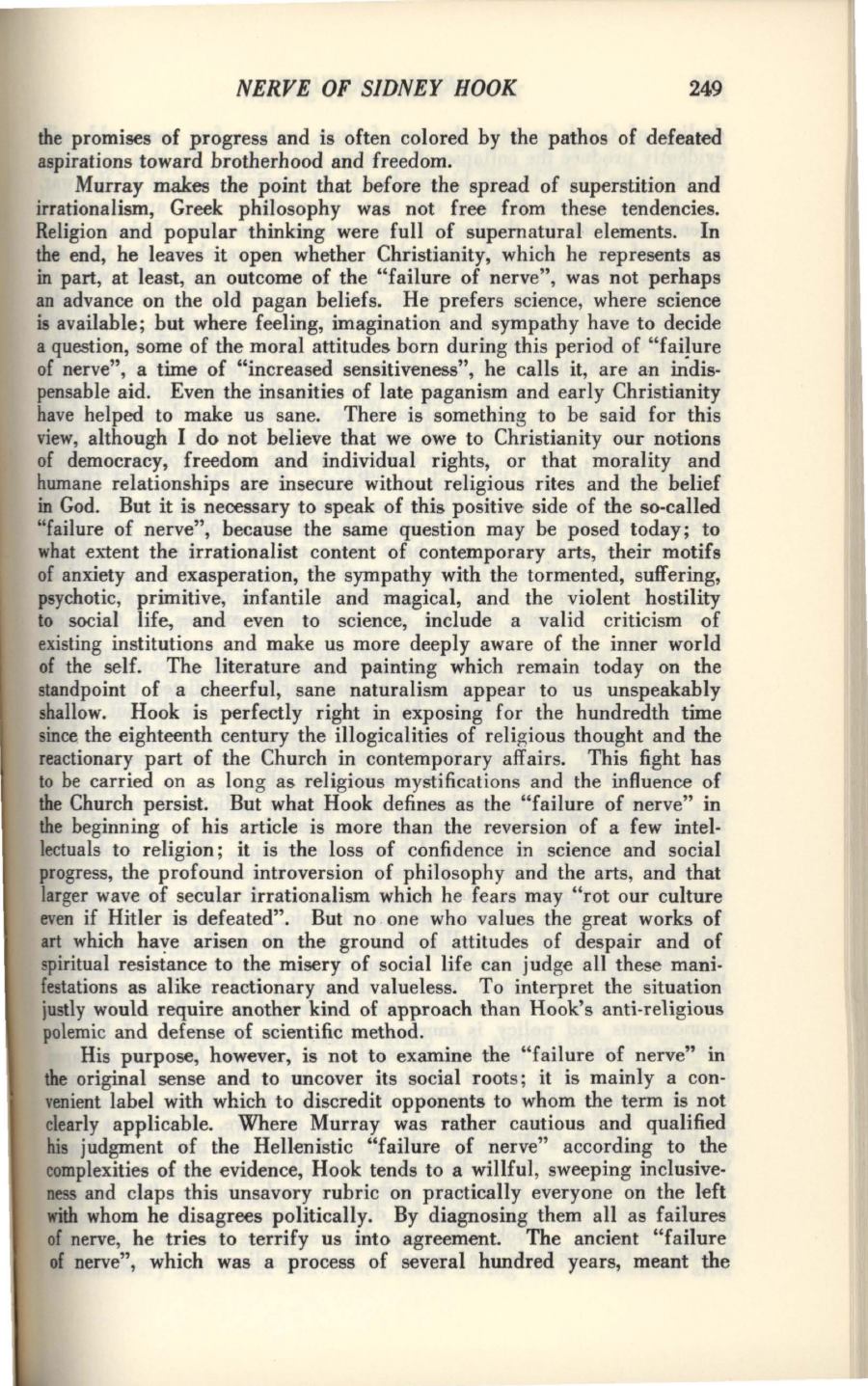
NERVE OF SIDNEY HOOK
249
the promises of progress and is often colored by the pathos of defeated
aspirations toward brotherhood and freedom.
Murray makes the point that before the spread of superstition and
irrationalism, Greek philosophy was not free from these tendencies.
Religion and popular thinking were full of supernatural elements. In
the end, he leaves it open whether Christianity, which he represents as
in part, at least, an outcome of the "failure of nerve", was not perhaps
an advance on the old pagan beliefs. He prefers science, where science
is
available; but where feeling, imagination and sympathy have to decide
a question, some of the moral attitudes born during this period of "faiJure
of nerve", a time of "increased sensitiveness", he calls it, are an indis–
pensable aid. Even the insanities of late paganism and early Christianity
have helped to make us sane. There is something to be said for this
view, although I do not believe that we owe to Christianity our notions
of democracy, freedom and individual rights, or that morality and
humane relationships are insecure without religious rites and the belief
in God. But it is necessary to speak of this positive side of the so-called
"failure of nerve", because the same question may be posed today; to
what eJ..1ent the irrationalist content of contemporary arts, their motifs
of anxiety and exasperation, the sympathy with the tormented, suffering,
psychotic, primitive, infantile and magical, and the violent hostility
to social life, and even to science, include a valid criticism of
existing institutions and make us more deeply aware of the inner world
of the self. The literature and painting which remain today on the
standpoint of a cheerful, sane naturalism appear to us unspeakably
shallow. Hook is perfectly right in exposing for the hundredth time
since. the eighteenth century the illogicalities of religious thought and the
reactionary part of the Church in contemporary affairs. This fight has
to be carried on as long as religious mystifications and the influence of
the Church persist. But what Hook defines as the "failure of nerve" in
the beginning of his article is more than the reversion of a few intel–
lectuals to religion; it is the loss of confidence in science and social
progress, the profound introversion of philosophy and the arts, and that
larger wave of secular irrationalism which he fears may "rot our culture
even if Hitler is defeated". But no one who values the great works of
art which have arisen on the ground of attitudes of despair and of
spiritual resistance to the misery of social life can judge all these mani–
festations as alike reactionary and valueless. To interpret the situation
justly would require another kind of approach than Hook's anti-religious
polemic and defense of scientific method.
His purpose, however, is not to examine the "failure of nerve" in
the original sense and to uncover its social roots;
it
is mainly a con–
venient label with which to discredit opponents to whom the term is not
clearly applicable. Where Murray was rather cautious and qualified
his judgment of the Hellenistic "failure of nerve" according to the
complexities of the evidence, Hook tends to a willful, sweeping inclusive–
ness
and claps this unsavory rubric on practically everyone on the left
with
whom he disagrees politically. By diagnosing them all as failures
of nerve, he tries to terrify us into agreement. The ancient "failure
of nerve", which was a process of several hundred years, meant the


